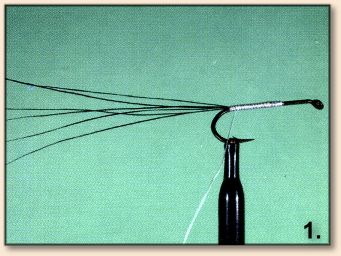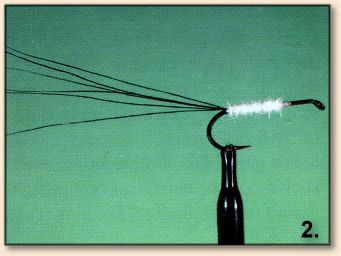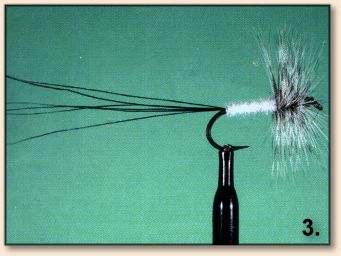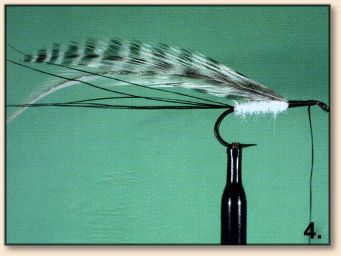The Canadian Catskills Coffin Fly
By Sheldon Seale
Having just returned from a trip to the Catskills
to meet the famous Green Drake hatch, I thought it
appropriate to write about the pattern that served
our crew the best. It is a simple form of the
Coffin Fly (the spinner stage of the green drake.)

If you've never experienced a Green Drake spinner
fall, you have missed one of the great spectacles
of fly fishing experience. At its peak, there are
tens of thousands of large, white mayflies flying
upstream to mate, then falling to the water to deposit
their eggs and die, drifting downstream into the
jaws of waiting prout. There is no mistaking a
large trout taking a Coffin Fly spinner. The take
is deliberate and moves a lot of water. It can get
you more than a little worked up.
Green Drake spinners are not difficult flies to imitate:
the original Coffin Fly consists simply of a tail, a body,
and a hackle. There are more complex patterns in the books,
but over the years I have found the three materials version
sufficient. This year, however, after much musing and debate
in the wee small hours with a dram or two of single malt, my
friend Paul and I added a fourth material, grizzly hackle.
I can take no credit for the idea. It all belongs to
Paul. His idea was touse the grizzly hackle to imitate
the venation of the wing (which, to our eyes anyway, is
quite distinct). I must confess that I resisted the
idea, as I felt it an unnecessary addition. Why take the
trouble to spend time making a pattern more imitative when
the original suggestive version was quite effective? I
shuttered to think that Paul's enthusiasm might lead him
to include wings, eyes, and six legs complete with joints!
Fortunately, he seemed content with just the extra hackle,
which proved every effective when we put it to the test on
the water the next day.
Canadian Castskill Coffin
Hook: 2x long, sizes 12-8 (Mustad 9671 or 94831 or similar).
Thread: White (for body), black (for hackle) 3/0
Tail: Moose mane or body, 4-5 fibres.
Body: White dubbing.
Hackle: One each of silver badger and grizzly quality
dry fly hackles, long enough to provide heavy hackling.
Tying Notes:
1. Start the white thread 1/3 back from the eye of the
hook and secure the tail. Wind the thread down to the
hook bend, keeping the tail material on top of the
hook shank.


2. Dub a body back to the starting point and tie off the
white thread.

3. Start the black thread just behind the hook eye and wrap it
back to the body. Tie in both the hackles at this point, then
bring the thread forward to the eye, ensuring a smooth surface
for wrapping the hackle.

4. Wrap the hackle seperately. I usually start with the
silver badger. As you wrap the second hackle through the
first, waggle the feather back and forth to minimize the
number of fibers trapped by the second hackle, form a neat
head, and coat with head cement.

5. There are a couple of ways to finish the pattern. One
is to trim the hackle flat on the body for the egg-laying
female (as in the photo above), while the other is to trim
it flat on top and bottom for the spent spinner.

Silver badger is a white feather with a black center. As it
can be difficult to find really pure white ones, just settle for
the lightest you can find. The fish don't really seem to
mind that much.
This basic pattern can be adapted for any large mayfly
such as the early and late Hexagenia or the Brown Drake.
In any case, it's relatively quick to tie and uses
materials that can generally be located without too
much trouble. ~ Sheldon Seale
We thank the Canadian Fly Fisher for re-print permission!
Our Man In Canada Archives
|

